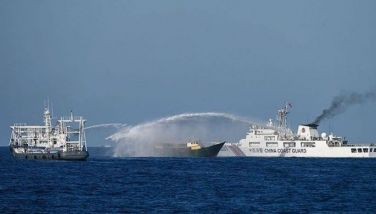Deadliest, most destructive cyclones of the Philippines
MANILA, Philippines - With thousands estimated to be dead in a single province alone, Super Typhoon "Yolanda" could be among the deadliest tropical cyclones to lash the country.
According to the National Statistical Coordination Board (NSCB), which cited data from state weather bureau PAGASA and typhoon2000.ph, the deadliest tropical cyclone to be recorded in Philippine history was "Uring," which ravaged the country in November 1991.
Uring (international name Thelma) was only a tropical storm with a highest wind speed of 95 kilometers per hour. But this tropical cyclone was able to kill 5,101 people and cost damage worth P1.04 billion.
The NSCB said the official death toll from Uring was even estimated to be at 8,000. "Missing persons were presumed dead, some [may be] devoured by sharks at Ormoc Bay and Camotes Sea."
Here are the other deadliest and most destructive typhoons to hit the Philippines before Yolanda:
Table: Worst Typhoons of the Philippines (1947 - 2011)
|
NAME |
PERIOD OF OCCURRENCE |
DEATHS |
DAMAGE IN BILLION PESOS |
AREAS MOST AFFECTED |
|
1. URING (Thelma) |
November 2-7, 1991 |
5,101 |
1.045 |
Leyte, Negros |
|
2. ROSING (Angela) |
October 30-November 4, 1995 |
936 |
10.829 |
Bicol Region, CALABARZON, NCR |
|
3. FRANK (Fengshen) |
June 18-23, 2008 |
938 |
13.321 |
Eastern-Western Visayas, Romblon, Marinduque, CALABARZON, NCR, Central Luzon |
|
4. NITANG (Ike) |
August 31-September 4, 1984 |
1,363 |
4.100 |
Surigao, Bohol, Cebu, Negros |
|
5. REMING (Durian) |
November 26-December 1, 2006 |
754 |
5.086 |
Bicol, CALABARZON, Marinduque, Mindoro |
|
6. RUPING (Mike) |
November 10-14, 1990 |
748 |
10.846 |
Northern Mindanao, Visayas |
|
7. SISANG (Nina) |
November 23-27, 1987 |
979 |
1.119 |
Bicol, Marinduque, CALABARZON |
|
8. SENING (Joan) |
October 11-15, 1970 |
768 |
1.890 |
Bicol, CALABARZON, NCR |
|
9. PEPENG (Parma) |
September 30-October 11, 2009 |
492 |
27.195 |
Northern Luzon, Cordillera |
|
10. LOLENG (Babs) |
October 15-24, 1998 |
303 |
6.787 |
Bicol, Central-Northern Luzon |
|
11. AMY |
December 6-19, 1951 |
991 |
0.700 |
Visayas |
|
12. UNDANG (Agnes) |
November 3-6, 1984 |
895 |
1.900 |
Samar, Leyte, Panay |
|
13. TRIX |
October 16-23, 1952 |
995 |
0.880 |
Bicol Region |
|
14. KADIANG (Flo) |
September 30-October 7, 1993 |
576 |
8.752 |
Northern-Central Luzon, Cordillera |
|
15. ONDOY (Ketsana) |
September 24-27, 2009 |
464 |
11.121 |
NCR, CALABARZON, Central Luzon |
|
16. ILIANG (Zeb) |
October 7-18, 1998 |
75 |
5.375 |
Northern Luzon |
|
17. UNSANG (Ruby) |
October 21-26, 1988 |
157 |
5.636 |
Bicol, Central-Northern Luzon |
|
18. HERMING (Betty) |
August 7-14, 1987 |
200 |
2.066 |
Northern Samar, Southern Bicol |
|
19. KADING (Rita) |
October 25-27, 1978 |
444 |
1.900 |
Central Luzon |
|
20. SALING (Dot) |
October 15-20, 1985 |
118 |
2.133 |
Northern Bicol, Central Luzon |
|
21. SENDONG (Washi) |
December 16-18, 2011 |
1,257 |
1.382 |
Region X, Region IX, Bicol Region, Region VII, VI, CARAGA |
data from NSCB, NDRRMC and typhoon2000.ph
Typhoon 'Pablo'
The NSCB data only covered 1947 to 2011, which means Typhoon Pablo did not make it to the agency's list.
In December 2, 2012, Pablo (international name Bopha) intensified and entered the Philippine Area of Responsibility. It made landfall over Baganga, Davao Oriental two days later and traversed Compostella Valley, Bukidnon and Negros Oriental.
"Powerful winds and floodwaters from the typhoon flattened homes as it smashed ashore on southern Davao Oriental province. Continuing westward, it blew over mountains, with heavy rains triggering flash floods in nearby Compostela Valley province that washed down tons of mud and boulders on helpless communities," an Associated Press report said.
The National Disaster Risk Reduction and Management Council (NDRRMC) said a total of 711,682 families or 6,243,998 people in 34 provinces were affected.
A total of 1,067 people were killed as of December 25, 2012, while 834 others were reported missing.
Estimated cost of damages to properties, infrastructure and agriculture was pegged at P36.9 billion.
Due to the devastation caused by Pablo, Pres. Benigno Aquino III declared the State of National Calamity on December 7, covering eight provinces, 44 municipalities and three cities.
Notable tropical cyclones
Some of the deadliest and most devastating tropical cyclones to hit the Philippines also had notable traits, according to the data of typhoon2000.ph, which claims itself as the country's first website on tropical cyclones.
Typhoon Rosing, which killed over 900 people in 1995, had unusually maintained winds of at least 240 kph for 60 hours, most of it while over land. In 2008, Typhoon Frank had a very erratic movement causing numerous forecasting errors and killing 938 people, including those from the sunken M/V Princess Of The Stars and various fishing fleets.
Typhoon Reming in 2006 was the most powerful typhoon ever recorded by PAGASA, registering a 320-kph wind gust at Virac Weather Station before the anemometer was damaged. Sening, meanwhile, was a very large super typhoon in 1970 with a radius covering the entire country.
In 2009, Typhoon Ondoy brought record flooding in Metro Manila and Rizal that drowned hundreds and stranded millions. In the same year, Typhoon Pepeng criss-crossed Northern Luzon making initial landfall at Cagayan, then looping back to landfall in Ilocos Norte, looped back again and entered Cagayan the second time.
Over 1,234 tropical cyclones since 1948
The NSCB said a total of 1,234 tropical cyclones entered the Philippine Area of Responsibility from 1948 to 2011. Of this number, 270 are tropical depressions, 354 are tropical storms and 610 are typhoons.
Based on the said figures, an average of 19 tropical cyclones enter the country each year, with nine making landfall or crossing the archipelago.
The year 1993 had the most number of tropical cyclones that entered the country with 32 and most number of tropical cyclones that landed or crossed with 19.
The NSCB said that according to the Center for Research on the Epidemiology of Disasters (CRED), the Philippines was among the top three countries with the highest number of natural disasters from 2008 to 2012.
Based on the CRED's Emergency Event Database, storms have already killed a total of 24,281 people in the Philippines from 1983 to 2012, while floods have killed a total of 2,013 people.
In the same timespan, storms affected a total of 99.6 million people while floods affected 14.9 million.
The economic damage caused by storms totalled to US$ 5.9 billion while about US $1.2 billion in damage was brought about by floods.
- Latest
- Trending





























